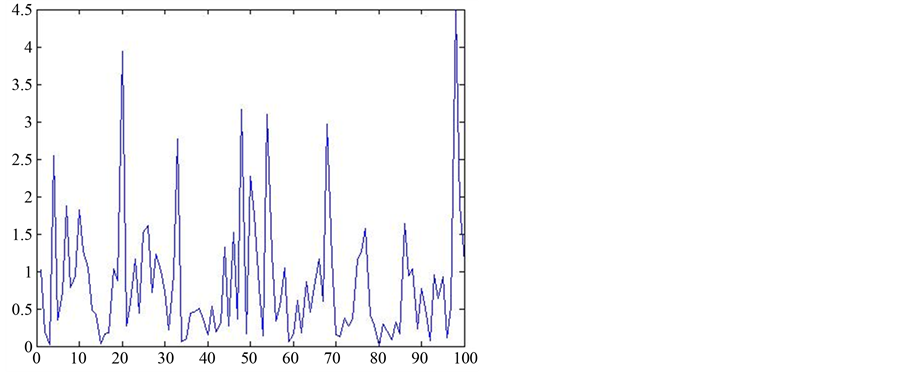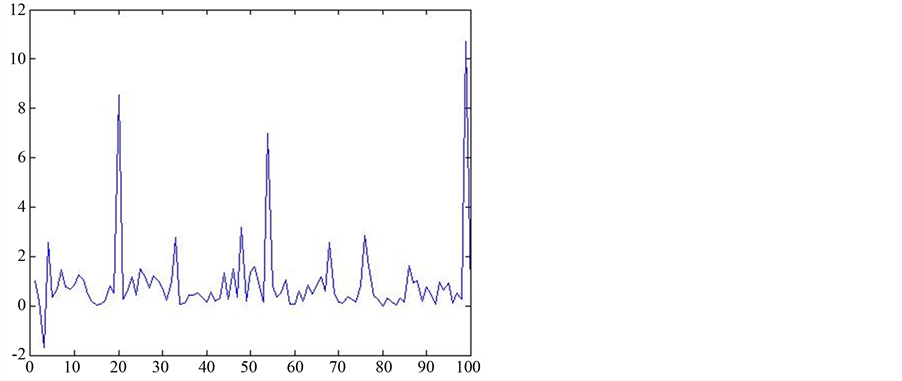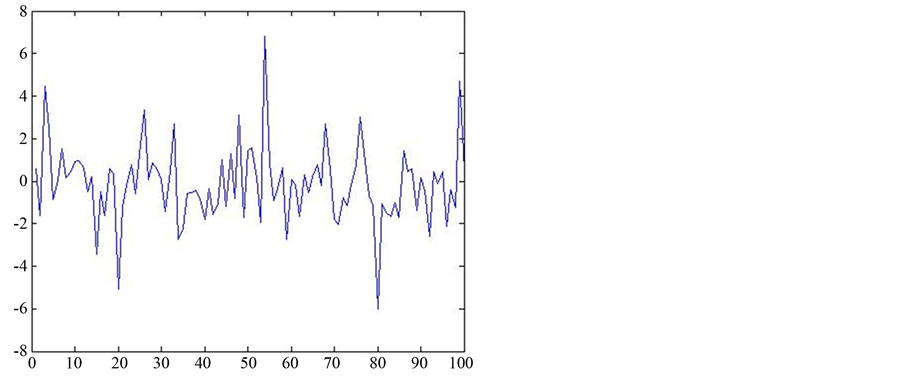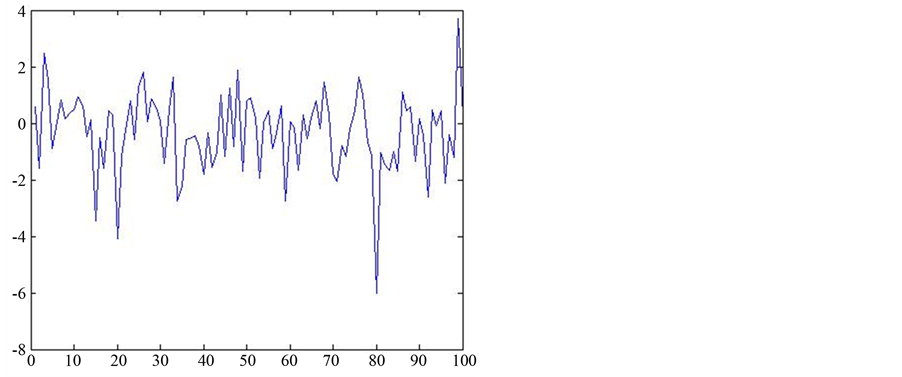Natural Science
Vol.6 No.10(2014), Article
ID:46952,11
pages
DOI:10.4236/ns.2014.610074
Statistical Diagnosis for General Transformation Model with Right Censored Data Based on Empirical Likelihood
Shuling Wang1, Xiaohong Deng1, Lin Zheng2
1Department of Fundamental Course, Air Force Logistics College, Xuzhou, China
2School of Statistics and Applied Mathematics, Anhui University of Finance and Economics, Bengbu, China
Email: 155328313@qq.com
Copyright © 2014 by authors and Scientific Research Publishing Inc.
This work is licensed under the Creative Commons Attribution International License (CC BY).
http://creativecommons.org/licenses/by/4.0/



Received 1 May 2014; revised 21 May 2014; accepted 8 June 2014
ABSTRACT
In this work, we consider statistical diagnostic for general transformation models with right censored data based on empirical likelihood. The models are a class of flexible semiparametric survival models and include many popular survival models as their special cases. Based on empirical likelihood methodologe, we define some diagnostic statistics. Through some simulation studies, we show that out proposed procedure can work fairly well.
Keywords:Random Right Censorship, Empirical Likelihood, Outliers, Influence Analysis

1. Introduction
Statistical diagnosis developed in the mid-1970s, which is a new statistical branch. In the course of development of the past 40 years, the diagnosis and influence analysis of linear regression model has been fully developed (R. D. Cook and S. Weisberg [1] , Bocheng Wei, Guobin Lu & Jianqing Shi [2] ). Influence diagnostics for the proportional hazards model has been fully developed (L. A. Weissfeld [3] ), for example, the proportional odds model, heteroscedastic linear transformation model, generalized linear transformation model, generalized transformation model and the other survival models.
The empirical likelihood method originates from Thomas & Grunkemeier [4] . Owen [5] first proposed the definition of empirical likelihood and expounded the system info of empirical likelihood. The empirical CDF of
 is defined as
is defined as  for
for . The empirical likelihood of the CDF
. The empirical likelihood of the CDF  is
is . Zhu and Ibrahim [6] utilized this method for statistical diagnostic, they developed diagnostic measures for assessing the influence of individual observations when using empirical likelihood with general estimating equations, and used these measures to construct goodness-of-fit statistics for testing possible misspecification in the estimating equations. Liugen Xue and Lixing Zhu [7] summarized the application of empirical likelihood method.
. Zhu and Ibrahim [6] utilized this method for statistical diagnostic, they developed diagnostic measures for assessing the influence of individual observations when using empirical likelihood with general estimating equations, and used these measures to construct goodness-of-fit statistics for testing possible misspecification in the estimating equations. Liugen Xue and Lixing Zhu [7] summarized the application of empirical likelihood method.
Many authors have successfully applied empirical likelihood to the analysis of survival data. For example, Qin and Jing [8] investigated empirical likelihood confidence intervals for Cox’s regression models with right censored data; He [9] studied the goodness-of-fit of Cox’s regression models with various types of censored data; Gu et al. [10] considered inferences for Cox’s regression models with time-dependent coefficients; Zhou [11] , Zheng and Yu [12] and Zhou et al. [13] studied empirical likelihood for accelerated failure time models, multivariate accelerated failure time models and heteroscedastic accelerated failure time models respectively. Li et al. [14] overviewed some applications of empirical likelihood in survival analysis; Lu and Liang [15] discussed empirical likelihood procedure based on estimating equations for a class of flexible survival models-lineartransformation models, which includes popular proportional hazard regression models and proportional odds regression models as its special cases. Jianbo Li et al. [16] studied empirical likelihood inference for general transformation models with right censored data.
In this paper, we will consider statistical diagnostic for a class of very general survival models-general transformation models with right censored data in the form of
 (1)
(1)
where  is the conditional survival function of failure time variable
is the conditional survival function of failure time variable  given covariate vector
given covariate vector ;
;  is a completely unspecified baseline survival function when
is a completely unspecified baseline survival function when ;
;  is a known monotonically increasing function with respect to
is a known monotonically increasing function with respect to  satisfying
satisfying  and
and  for any
for any  and
and ;
;  is a parameter vector including regression coefficients and possible model transformation parameters in
is a parameter vector including regression coefficients and possible model transformation parameters in . Model (1) includes many popular survival models, for example heteroscedastic linear transformation models, as their special cases. Note that when
. Model (1) includes many popular survival models, for example heteroscedastic linear transformation models, as their special cases. Note that when

where  is a survival function, Model (1) reduces to the popular linear transformation models (Clayton and Cuzik [17] ; Dabrowska and Doksum [18] ; Bickel [19] ; Cheng et al. [20] ; Fine et al. [21] ).
is a survival function, Model (1) reduces to the popular linear transformation models (Clayton and Cuzik [17] ; Dabrowska and Doksum [18] ; Bickel [19] ; Cheng et al. [20] ; Fine et al. [21] ).
So far the diagnosis of the general transformation model with random right censorship based on empirical likelihood method has not yet seen in the literature. This paper attempts to study it. One advantage of this procedure is that it is free of baseline survival function and censoring distribution. The class of models we investigate is also general than previous studies for survival models.
The rest of the paper is organized as follows. Empirical likelihood and estimation equation are presented in Section 2. The main results are given in Section 3 and Section 4. Section 5 contains some simulation studies as well as applications. Conclusions with discussions are given in Section 6.
2. Empirical Likelihood and Estimation Equation
Let  be the censoring variable,
be the censoring variable,  be the censored event time variable and
be the censored event time variable and  be the censoring indicator. Suppose
be the censoring indicator. Suppose  are
are  i.i.d. copies of
i.i.d. copies of . Denote by
. Denote by  the total number of uncensored failure times.
the total number of uncensored failure times. , the partial ranking among the
, the partial ranking among the  uncensored failure times and the censored observations between each neighboring pair of uncensored observations. Given the partial ranking
uncensored failure times and the censored observations between each neighboring pair of uncensored observations. Given the partial ranking  and covariate observations
and covariate observations , Jianbo Li [16] has proposed the empirical log-likelihood ratio function for
, Jianbo Li [16] has proposed the empirical log-likelihood ratio function for  can be defined by
can be defined by

where ,
,
 ,
,
 ,
,
 ,
,
 .
.
By Qin and Lawless [22] , Owen [5] , when

the empirical log-likelihood ratio statistic equal to the maximum
 where
where  and
and .
.
Regard  and
and  as independent variable and define
as independent variable and define
 .
.
Obviously, the maximum empirical likelihood estimates  and
and  are the solutions of following equations
are the solutions of following equations
 .
.
3. Case-Deletion Influence Measures
Consider Model (1), where the j-th case  is deleted.
is deleted.
 . (2)
. (2)
This model is called case-deletion model. Let  is the maximum empirical likelihood estimate of
is the maximum empirical likelihood estimate of  in model (2). In order to study the influence of the j-th case
in model (2). In order to study the influence of the j-th case , and compare the difference between
, and compare the difference between  and
and
 . The important result as follows theorem.
. The important result as follows theorem.
By Zhu, et al. [6] , for model (2), the maximum empirical likelihood estimator of  is
is
 , (3)
, (3)
where ,
, .
.
3.1. Empirical Cook Distance
Zhu, et al. [6] proposed empirical cook distance. Let M is a nonnegative matrix. The empirical cook distance is defined as follows
 (4)
(4)
where .
.
3.2. Empirical Likelihood Distance
Empirical likelihood distance is advanced from the view of data fitting. Considering the influence of deleting the j-th case. In order to eliminate the influence of scale, it is also need to divide the variance of estimator .
.
Because the keystone is to review the influence of deleting the j-th case. Hence,  is substituted by
is substituted by . Then, the W-K statistic can be expressed as follows
. Then, the W-K statistic can be expressed as follows
 (5)
(5)
4. Local Influence Analysis of Model
We consider the local influence method for a case-weight perturbation , for which the empirical log-likelihood function
, for which the empirical log-likelihood function  is defined by
is defined by . In this case,
. In this case,  , defined to be an
, defined to be an
 vector with all elements equal to 1, represents no perturbation to the empirical likelihood, because
vector with all elements equal to 1, represents no perturbation to the empirical likelihood, because . Thus, the empirical likelihood displacement is defined as
. Thus, the empirical likelihood displacement is defined as

where  is the maximum empirical likelihood estimator of
is the maximum empirical likelihood estimator of  based on
based on . Let
. Let  with
with  and
and

where  is a direction in
is a direction in . Thus, the normal curvature of the influence graph
. Thus, the normal curvature of the influence graph  is given by
is given by

where  in which
in which  is a
is a 
matrix with  -th element given by
-th element given by .
.
We consider two local influence measures based on the normal curvature  as follows. Let
as follows. Let
 be the ordered eigen values of the matrix
be the ordered eigen values of the matrix  and let
and let
 be the associated orthonormal basis, that is,
be the associated orthonormal basis, that is, . Thus, the spectral decomposition of
. Thus, the spectral decomposition of  is given by
is given by
 .
.
The most popular local influence measures include , which corresponds the largest eigen value
, which corresponds the largest eigen value , as well as
, as well as ,where
,where  is an
is an  vector with j-th component 1 and 0 otherwise. The
vector with j-th component 1 and 0 otherwise. The  represents the most influential perturbation to the empirical likelihood function, whereas the observation
represents the most influential perturbation to the empirical likelihood function, whereas the observation  with a large
with a large  can be regarded as influential.
can be regarded as influential.
As the discuss of Zhu et al. [6] , for the general transformation regression model with random right censorship, we can deduce that
 (6)
(6)
where ,
,
 ,
,



 .
.
5. Numerical Studies
In this section, we simulate data with sample sizes  from the follow transformation model
from the follow transformation model

where ,
,  ,
,  ,
,  ,
,  , where
, where  denotes the Bernoulli distribution and
denotes the Bernoulli distribution and  denotes the uniform distribution. For the simulation studies, we will consider three choices of
denotes the uniform distribution. For the simulation studies, we will consider three choices of : 1) standard exponential survival function 2)
: 1) standard exponential survival function 2) . Note that when
. Note that when  takes standard exponential survival function and
takes standard exponential survival function and , Model (1) corresponds to the proportional hazard Cox regression model and the proportional odds regression model. For all two models, we will generate censoring times from
, Model (1) corresponds to the proportional hazard Cox regression model and the proportional odds regression model. For all two models, we will generate censoring times from . By properly choosing values of
. By properly choosing values of , we consider three censoring proportions
, we consider three censoring proportions  for all the cases (Qian Jun, et al. [23] ). The survival data simulated by software SAS as follows Table 1.
for all the cases (Qian Jun, et al. [23] ). The survival data simulated by software SAS as follows Table 1.
In order to check out the validity of our proposed methodology, we change the response variable value of the third, 20th, 54th, 80th and 99th data.
For every case, it is easy to obtain . For the parameters
. For the parameters  and
and , using the samples, we evaluated their maximum empirical likelihood estimators for two models.
, using the samples, we evaluated their maximum empirical likelihood estimators for two models.
Consequently, it is easy to calculate the value of  and
and . The result of
. The result of  is as following figures.
is as following figures.
From all figures, we can see that in most cases, the value of  are reasonably close to one fixed value. Following the definition and properties of
are reasonably close to one fixed value. Following the definition and properties of , we can diagnose the strong influence points, the value of which deviate from the average seriously. From Figures 1-3, we can see from the value of
, we can diagnose the strong influence points, the value of which deviate from the average seriously. From Figures 1-3, we can see from the value of  that the third, 20th, 54th and 80th data are strong influence point. From Figures 4-6, we can see from the value of
that the third, 20th, 54th and 80th data are strong influence point. From Figures 4-6, we can see from the value of  that the third, 20th, 54th, 80th and 99th data are strong influence point. Indeed, our proposed approaches are illustrated.
that the third, 20th, 54th, 80th and 99th data are strong influence point. Indeed, our proposed approaches are illustrated.
6. Discussion
In this paper, we considered the statistical diagnostic for general transformation models with right censored data based on empirical likelihood. We also studied in detail the method of simulating survival data under three different censored proportions. Through simulation studies, we illustrate that our proposed method can work fairly well.
Zhensheng Huang [24] analyzed empirical likelihood for varying-coefficient single-index model with right censored data. In addition, Zhengsheng Huang [25] studied profile empirical likelihood inferences for the single
Table 1. Survival data (Note: the “star” in top right corner represent censored data).

Figure 1. The influence  of Model (1)
of Model (1) .
.

Figure 2. The influence  of Model (1)
of Model (1) .
.

Figure 3. The influence  of Model (1)
of Model (1) .
.

Figure 4. The influence  of Model (2)
of Model (2) .
.

Figure 5. The influence  of Model (2)
of Model (2) .
.

Figure 6. The influence  of Model (2)
of Model (2) .
.
index-coefficient regression model. All of these will be topics for our further research.
References
- Cook, R.D. and Weisberg, S. (1982) Residuals and Influence in Regression. Chapman and Hall, New York.
- Wei, B.C., Lu, G.B. and Shi, J.Q. (1990) Statistical Diagnostics. Publishing House of Southeast University, Nanjing.
- Weissfeld, L.A. (1990) Influence Diagnostics for the Proportional Hazards Model. Statistics & Probability Letters, 10, 411-417. http://dx.doi.org/10.1016/0167-7152(90)90022-Y
- Thomas, D.R. and Grunkemeier, G.L. (1975) Confidence Interval Estimation of Survival Interval Estimation of Survival Probabilities for Censored Data. Journal of the American Statistical Association, 70, 865-871. http://dx.doi.org/10.1080/01621459.1975.10480315
- Owen, A. (2001) Empirical Likelihood. Chapman and Hall, New York. http://dx.doi.org/10.1201/9781420036152
- Zhu, H.T., Ibrahim, J.G. and Tang, N.S., et al. (2008) Diagnostic Measures for Empirical Likelihood of Generalized Estimating Equations. Biometrika, 99, 489-507. http://dx.doi.org/10.1093/biomet/asm094
- Xue, L.G. and Zhu, L.X. (2010) Empirical Likelihood in Nonparametric and Semiparametric Models. Science Press, Beijing.
- Qin, G. and Jing, B. (2001) Empirical Likelihood for Cox Regression Model under Random Censorship. Communication in Statistics—Simulation and Computation, 30, 79-90.
- He, B. (2006) Application of the Empirical Likelihood Method in Propotional Hazards Model. Ph.D. Thesis, University of Central Florida, Orlando.
- Gu, M., Sun, L. and Zuo, G. (2005) A Baseline-Free Procedure for Tansformation Models under Interval Censorship. Lifetime Data Analysis, 11, 437-488. http://dx.doi.org/10.1007/s10985-005-5235-x
- Zhou, M. (2005) Empirical Likelihood Analysis of the Rank Estimator for the Censored Accelerated Failure Time Model. Biometrika, 92, 492-498. http://dx.doi.org/10.1093/biomet/92.2.492
- Zheng, M. and Yu, W. (2011) Empirical Likelihood Method for the Multivariate Accelerated Filure Time Models. Journal of Statistical Planning and Inference, 141, 972-983. http://dx.doi.org/10.1016/j.jspi.2010.09.001
- Zhou, M., Kim, M. and Bathke, A. (2012) Empirical Likelihood Analysis for the Heteroscedastic Accelerated Failure Time Model. Statistica Sinica, 22, 295-316.
- Li, G., Li, R. and Zhou, M. (2005) Empirical Likelihood in Survival Analysis. In: Fan, J. and Li, G., Eds., Contemporary Multivariate Analysis and Design of Experiments, World Scientific, Singapore City, 337-350. http://dx.doi.org/10.1142/9789812567765_0020
- Lu, W. and Liang, Y. (2006) Empirical Likelihood Inference for Linear Transformation Models. Journal of Multivariate Analysis, 97, 1586-1599. http://dx.doi.org/10.1016/j.jmva.2005.09.007
- Li, J.B., Huang, Z.S. and Lian, H. (2013) Empirical Likelihood Influence for General Transformation Models with Right Censored Data. Statistics and Computing, 8, 1-10. http://dx.doi.org/10.1007/s11222-013-9415-3
- Clayton, D. and Cuzick, J. (1985) Multivariate Generalizations of the Proportional Hazards Model. Royal Statistical Society A, 48, 82-117. http://dx.doi.org/10.2307/2981943
- Dabrowska, D. and Doksum, K. (1988) Partial Likelihood in Transformation Models with Censoring Data. Scandinavian Journal of Statistics, 15, 1-23.
- Bickel, P. (1998) Efficient and Adaptive Estimation for Semiparametric Models. Springer, Berlin.
- Cheng, S., Wei, L. and Ying, Z. (1995) Analysis of Transformation Models with Censored Data. Biometrika, 82, 835-845. http://dx.doi.org/10.1093/biomet/82.4.835
- Fine, J., Ying, Z. and Wei, L. (1998) On the Linear Transformation Model for Censored Data. Biometrika, 85, 980-986. http://dx.doi.org/10.1093/biomet/85.4.980
- Qin, J. and Lawless, J. (1994) Empirical Likelihood and General Estimating Equations. Annals of Statistics, 22, 300- 325. http://dx.doi.org/10.1214/aos/1176325370
- Jun, Q., et al. (2013) Simulate Survival Data under Different Censored Proporions. Journal of Mathematical Medicine, 26, 644-646.
- Huang, Z.S. (2012) Empirical Likelihood for Varying-Coefficient Single-Index Model with Right-Censored Data. Metrika, 75, 55-71. http://dx.doi.org/10.1007/s00184-010-0314-8
- Huang, Z.S. and Zhang, R.Q. (2013) Profile Empirical-Likelihood Inferences for the Single-Index-Coefficient Regression Model. Statistics and Computing, 23, 455-465. http://dx.doi.org/10.1007/s11222-012-9322-z


